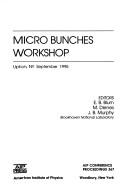| Listing 1 - 8 of 8 |
Sort by
|
Book
ISBN: 1786209632 1786209721 Year: 2023 Publisher: London : Geological Society,
Abstract | Keywords | Export | Availability | Bookmark
 Loading...
Loading...Choose an application
- Reference Manager
- EndNote
- RefWorks (Direct export to RefWorks)
Papers in this special publication mirror Maarten's career as a leading expert on Gondwana evolution andArchean tectonics. Maarten also contributed to our understanding of Archean life, African erosionalhistory and South African shale-gas development, and was a vigorous supporter of the advancement ofSouth African students from varied backgrounds.
Geology, Structural. --- De Wit, Maarten J. --- Gondwana (Continent)
Book
Abstract | Keywords | Export | Availability | Bookmark
 Loading...
Loading...Choose an application
- Reference Manager
- EndNote
- RefWorks (Direct export to RefWorks)
Book
ISBN: 1862399107 Year: 2009 Publisher: London Geological Society
Abstract | Keywords | Export | Availability | Bookmark
 Loading...
Loading...Choose an application
- Reference Manager
- EndNote
- RefWorks (Direct export to RefWorks)
Orogeny --- Orogenic belts --- Geology, Structural --- Geology --- Earth & Environmental Sciences --- Dynamic & Structural Geology
Book
ISBN: 1786204355 Year: 2016 Publisher: London : The Geological Society,
Abstract | Keywords | Export | Availability | Bookmark
 Loading...
Loading...Choose an application
- Reference Manager
- EndNote
- RefWorks (Direct export to RefWorks)
The supercontinent-cycle hypothesis attributes planetary-scale episodic tectonic events to an intrinsic self-organizing mode of mantle convection, governed by the buoyancy of continental lithosphere that resists subduction during the closure of old ocean basins, and the consequent reorganization of mantle convection cells leading to the opening of new ocean basins. Characteristic timescales of the cycle are typically 500 to 700 million years. Proposed spatial patterns of cyclicity range from hemispheric (introversion) to antipodal (extroversion), to precisely between those end members (orthoversion). Advances in our understanding can arise from theoretical or numerical modelling, primary data acquisition relevant to continental reconstructions, and spatiotemporal correlations between plate kinematics, geodynamic events and palaeoenvironmental history. The palaeogeographic record of supercontinental tectonics on Earth is still under development. The contributions in this Special Publication provide snapshots in time of these investigations and indicate that Earth's palaeogeographic record incorporates elements of all three end-member spatial patterns.--
Continents. --- Continents. --- Continents --- Pangée (continent) --- Dérive. --- Rodinia (Supercontinent) --- Pangaea (Supercontinent) --- Pangaea (Supercontinent)
Book
ISBN: 1786209918 1862392994 Year: 2021 Publisher: London : The Geological Society,
Abstract | Keywords | Export | Availability | Bookmark
 Loading...
Loading...Choose an application
- Reference Manager
- EndNote
- RefWorks (Direct export to RefWorks)
This text celebrates the career of R. Damian Nance. It features 27 articles, with more than 110 authors based in 18 different countries. These articles include contributions on the processes responsible for the formation and breakup of supercontinents, the controversies concerning the status of Pannotia as a supercontinent, the generation and destruction of Paleozoic oceans, and the development of the Appalachian-Ouachitan- Caledonide-Variscan orogens. In addition to field work, the approaches to gain that understanding include examining the relationships between stratigraphy and structural geology, precise geochronology, geochemical and isotopic fingerprinting, geodynamic modelling, regional syntheses, palaeogeographic modelling, and good old-fashioned arm-waving! The wide range of topics mirrors the breadth and depth of Damian's contributions, interests and expertise.
Orogeny. --- Continents.
Book
ISBN: 9781862397330 1862397333 Year: 2016 Publisher: London : The Geological society,
Abstract | Keywords | Export | Availability | Bookmark
 Loading...
Loading...Choose an application
- Reference Manager
- EndNote
- RefWorks (Direct export to RefWorks)
The supercontinent-cycle hypothesis attributes planetary-scale episodic tectonic events to an intrinsic self-organizing mode of mantle convection, governed by the buoyancy of continental lithosphere that resists subduction during the closure of old ocean basins, and the consequent reorganization of mantle convection cells leading to the opening of new ocean basins. Characteristic timescales of the cycle are typically 500 to 700 million years. Proposed spatial patterns of cyclicity range from hemispheric (introversion) to antipodal (extroversion), to precisely between those end members (orthoversion). Advances in our understanding can arise from theoretical or numerical modelling, primary data acquisition relevant to continental reconstructions, and spatiotemporal correlations between plate kinematics, geodynamic events and palaeoenvironmental history. The palaeogeographic record of supercontinental tectonics on Earth is still under development. The contributions in this Special Publication provide snapshots in time of these investigations and indicate that Earth's palaeogeographic record incorporates elements of all three end-member spatial patterns.--
Plate tectonics. --- Geology --- Periodicity. --- Continents. --- Pangaea (Supercontinent) --- Rodinia (Supercontinent) --- Pangea (Supercontinent) --- Continents

ISBN: 1563965550 Year: 1996
Abstract | Keywords | Export | Availability | Bookmark
 Loading...
Loading...Choose an application
- Reference Manager
- EndNote
- RefWorks (Direct export to RefWorks)
Book
ISBN: 0813795540 Year: 2022 Publisher: Geological Society of America
Abstract | Keywords | Export | Availability | Bookmark
 Loading...
Loading...Choose an application
- Reference Manager
- EndNote
- RefWorks (Direct export to RefWorks)
"This volume provides a comprehensive overview of our understanding of the evolution of the Appalachian-Caledonian-Variscan orogen. It takes the reader along a clockwise path around the North Atlantic Ocean from the U.S. and Canadian Appalachians; to the Caledonides of Spitsbergen, Scandinavia, Scotland and Ireland; and thence south to the Variscides of Morocco"--
Geology, Stratigraphic --- Orogeny. --- Orogenic belts --- Orogenic belts
| Listing 1 - 8 of 8 |
Sort by
|

 Search
Search Feedback
Feedback About UniCat
About UniCat  Help
Help News
News